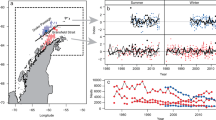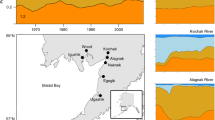Abstract
Macaroni penguins have evolved to cope with the highly variable conditions of the Southern Ocean. However, changes in prey supply and patchiness potentially associated with changes in climate and krill fishing activity may be occurring too rapidly for the penguins to adapt. We use a stochastic dynamic programming model to examine how changes in both the mean and patchiness of krill supply may affect the foraging decisions, and therefore breeding success, of female macaroni penguins at South Georgia. We predict that rapid changes in the mean supply of prey will have more of an effect on the condition of the female and chick than changes in prey patchiness, and that changes in foraging behavior compensate for changes in prey up to a threshold point, beyond which breeding success is likely impacted. In particular, we predict that the location of the threshold is affected by whether or not the penguins are adapted to the prey environment in which they are foraging, with the female and chick receiving on average 20% less of their daily energetic requirement if the female is not foraging optimally.





Similar content being viewed by others
References
Atkinson A, Siegel V, Pakhomov E, Rothery P (2004) Long-term decline in krill stock and increase in salps within the Southern Ocean. Nature 432:100–103
Atkinson A, Whitehouse MJ, Priddle J, Cripps GC, Ward P, Brandon MA (2001) South Georgia, Antarctica: a productive, cold water, pelagic ecosystem. Mar Ecol Prog Ser 216:279–308
Barlow KE, Boyd IL, Croxall JP, Reid K, Staniland IJ, Brierley AS (2002) Are penguins and seals in competition for Antarctic krill at South Georgia? Mar Biol 140:205–213
Barlow KE, Croxall JP (2002a) Provisioning behaviour of Macaroni Penguins Eudyptes chrysolophus. Ibis 144:248–258
Barlow KE, Croxall JP (2002b) Seasonal and interannual variation in foraging range and habitat of macaroni penguins Eudyptes chrysolophus at South Georgia. Mar Ecol Prog Ser 232:291–304
Berteaux D, Reale D, McAdam AG, Boutin S (2004) Keeping pace with fast climate change: can arctic life count on evolution? Integr Comp Biol 44:140–151
Bradshaw WE, Holzapfel CM (2006) Evolutionary response to rapid climate change. Science 312:1477–1478
Brown CR (1987a) Energy-requirements for growth and maintenance in macaroni and Rockhopper penguins. Polar Biol 8:95–102
Brown CR (1987b) Travelling speed and foraging range of macaroni and rockhopper penguins at Marion Island. J Field Ornithol 58:118–125
Clark CW (1974) Possible effects of schooling on the dynamics of exploited fish populations. J du Conseil International pour l’Exploration de la Mer 36:7–14
Clark CW, Mangel M (2000) Dynamic state variable models in ecology. Oxford University Press, Oxford
Clarke A, Murphy EJ, Meridith MP, King JC, Peck LS, Barnes DKA, Smith RC (2007) Climate change and the marine ecosystem of the western Antarctic Peninsula. Philos Trans R Soc Lond B 362:149–166
Clarke BD, Bemis W (1979) Kinematics of swimming penguins at the Detroit zoo. J Zool 188:411–428
Cresswell KA, Tarling GA, Trathan PN (2007) Weight loss during breeding is adaptive for female macaroni penguins, Eudyptes chrysolophus. Evol Ecol Res 9:1053–1076
Croxall JP, Nicol S (2004) Management of Southern Ocean fisheries: global forces and future sustainability. Antarct Sci 16:569–584
Croxall JP, Briggs DR, Kato A, Naito Y, Watanuki Y, Williams TD (1993) Diving pattern and performance in the macaroni penguin Eudyptes chrysolophus. J Zool 230:31–47
Croxall JP, Reid K, Prince PA (1999) Diet, provisioning and productivity responses of marine predators to differences in availability of Antarctic krill. Mar Ecol Prog Ser 177:115–131
Everson I, Goss C (1991) Krill fishing activity in the southwest Atlantic. Antarct Sci 3:351–358
Fraser WR, Hofmann EE (2003) A predator’s perspective on causal links between climate change, physical forcing and ecosystem response. Mar Ecol Prog Ser 265:1–15
Fraser WR, Trivelpiece WZ, Ainley DG, Trivelpiece SG (1992) Increases in Antarctic penguin populations: reduced competition with whales or a loss of sea ice due to environmental warming? Polar Biol 11:525–531
Godlewska M (1996) Vertical migrations of krill (Euphausia superba Dana). Pol Arch Hydrobiol 14:9–63
Green JA, Butler RJ, Woakes AJ, Boyd IL (2003) Energetics of diving in macaroni penguins. J Exp Biol 206:43–57
Hamilton WD (1971) Geometry for the selfish herd. J Theor Biol 31(2):295–311
Hennicke JC, Culik BM (2005) Foraging performance and reproductive success of Humboldt penguins in relation to prey availability. Mar Ecol Prog Ser 296:173–181
Hewitt RP, Demer DA (2000) The use of acoustic sampling to estimate the dispersion and abundance of euphausiids, with an emphasis on Antarctic krill, Euphausia superba. Fish Res 47:215–229
Houston A, McNamara J (1999) Models of adaptive behavior: an approach based on state. Cambridge University Press, Cambridge
Kawaguchi S, Nicol S (2006) Fishing ground selection in the Antarctic krill fishery: trends in patterns across years, seasons and nations. CCAMLR Sci 13:117
King JC (1994) Recent climate variability in the vicinity of the Antarctic Peninsula. Int J Climatol 14:357–369
Loeb V, Siegel V, Holm-Hansen O, Hewitt R, Fraser W, Trivelpiece WZ, Trivelpiece SG (1997) Effects of sea-ice extent and krill or salp dominance on the Antarctic food web. Nature 387:897–900
Lynnes AS, Reid K, Croxall JP (2004) Diet and reproductive success of Adelie and chinstrap penguins: linking response of predators to prey population dynamics. Polar Biol 27:544–554
Makarov RR, Maslennikov VV, Solyankin EV, Spiridonov VA, Yakovlev VN (1988) Variability in population density of Antarctic krill in the western Scotia Sea in relation to hydrological conditions. In: Sahrhage D (ed) Antarctic ocean and resources variability. Springer, Berlin, pp 231–244
Mangel M (1994) Spatial patterning in resource exploitation and conservation. Philos Trans R Soc Lond B 343:93–98
Mangel M (2006) The theoretical biologist’s toolbox. Cambridge University Press, Cambridge
Mangel M, Clark C (1988) Dynamic modeling in behavioral ecology. Princeton University Press, Princeton
McCarty JP (2001) Ecological consequences of recent climate change. Conserv Biol 15:320–331
Murphy EJ, Trathan PN, Everson I (1997) Krill fishing in the Scotia Sea in relation to bathymetry, including the detailed distribution around South Georgia. CCAMLR Sci 4:1–17
Nicol S, Endo Y (1997) Krill fisheries of the world. FAO Fisheries technical paper no. 367, 100p
Nicol S (2006) Krill, currents, sea ice: Euphausia superba and its changing environment. Bioscience 56:111–120
Nicol S, Constable AJ, Pauly T (2000a) Estimates of circumpolar abundance of Antarctic krill based on recent acoustic density measurements. CCAMLR Sci 7:87–99
Nicol S, Forster I, Spence J (2000b) Products derived from krill. In: Everson I (eds) Krill biology, ecology and fisheries. Blackwell Science, Oxford, pp 262–283
Reid K, Murphy EJ, Loeb V, Hewitt RP (2002) Krill population dynamics in the Scotia Sea: variability in growth and mortality within a single population. J Mar Syst 36:1–10
Rice KJ, Emery NC (2003) Managing microevolution: restoration in the face of global change. Front Ecol Environ 1:469–478
Ritz D (1994) Social aggregations in pelagic invertebrates. Adv Mar Biol 30:155–216
Roitberg BD, Mangel M (1997) Individuals on the landscape: behavior can mitigate landscape differences among habitats. Oikos 80:234–240
SC-CCAMLR (2001) Report of the twentieth meeting of the Scientific Committee (SCCAMLR-XX) CCAMLR, Hobart, Australia, p 557
Siegel V (2000) Krill (Euphausiacea) demography and variability in abundance and distribution. Can J Fish Aquat Sci 57:151–167
Smetacek V, Nicol S (2005) Polar ocean ecosystems in a changing world. Nature 437:362–368
Stockwell CA, Hendry AP, Kinnison MT (2003) Contemporary evolution meets conservation biology. Trends Ecol Evol 18:94–101
Swadling KM, Ritz DA, Nicol S, Osborn JE, Gurney LJ (2005) Respiration rate and cost of swimming for Antarctic krill, Euphausia superba, in large groups in the laboratory. Mar Biol 146:1169–1175
Trathan PN, Brierley AS, Brandon MA, Bone DG, Goss C, Grant SA, Murphy EJ, Watkins JL (2003) Oceanographic variability and changes in Antarctic krill (Euphausia superba) abundance at South Georgia. Fish Oceanogr 12:569–583
Trathan PN, Green C, Tanton J, Peat H, Poncet J, Morton A (2006) Foraging dynamics of macaroni penguins Eudyptes chrysolophus at South Georgia during brood-guard. Mar Ecol Prog Ser 323:239–251
Williams AJ (1982) Chick-feeding rates of macaroni and Rockhopper penguins at Marion Island. Ostrich 53:129–134
Williams TD, Croxall JP (1991) Annual variation in breeding biology of macaroni penguins, Eudyptes chrysolophus, at Bird Island, South Georgia. J Zool 223:189–202
Williams TD, Ghebremeskel K, Williams G, Crawford MA (1992) Breeding and molting fasts in macaroni penguins––do birds exhaust their fat reserves. Comp Biochem Physiol A 103:783–785
Witek Z, Kalinowski J, Grelowski A, Wolnomiejski N (1981) Studies of aggregations of krill (Euphausia superba). Meeresforschung/Rep Mar Res 28:228–243
Acknowledgments
This work was supported by the Lenfest Ocean Program and conducted at the Center for Stock Assessment Research, a partnership between the NMFS Santa Cruz Laboratory and the University of California, Santa Cruz.
Author information
Authors and Affiliations
Corresponding author
Rights and permissions
About this article
Cite this article
Cresswell, K.A., Wiedenmann, J. & Mangel, M. Can macaroni penguins keep up with climate- and fishing-induced changes in krill?. Polar Biol 31, 641–649 (2008). https://doi.org/10.1007/s00300-007-0401-0
Received:
Revised:
Accepted:
Published:
Issue Date:
DOI: https://doi.org/10.1007/s00300-007-0401-0




